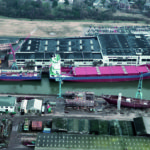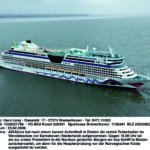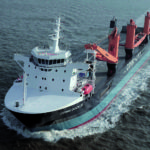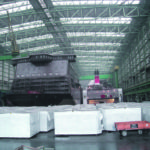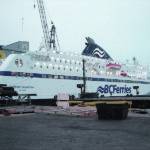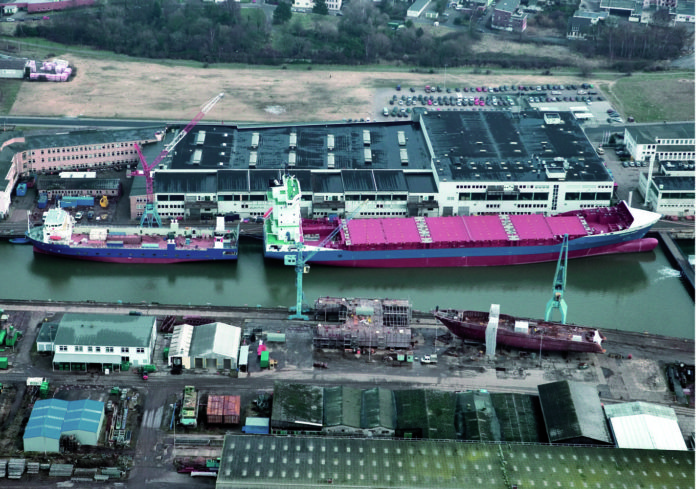
German shipyards have to fight hard for their survival again. After some years of good deliveries and consequently financial results in mainly a kind of series production of container vessels, especially this market segment creates new problems following the global economical crisis. Lately more [ds_preview]than 50 % of the yards’ production was done in container vessels, a ship type that is not requested any more at least in the near future. Consequently it is said the future of shipbuilding lies in special ships. But what means special?
Nearly four decades ago the global shipbuilding nations especially in Far-East and Europe were trying to evaluate their production volumes and find some bases for agreements. The question of establishing a consistent unit of measurement for newbuilding production by shipyards was considered at meetings between the Community of European Shipyards Associations (CESA) – at that time the Association of West-European Shipbuilders (AWES) – and the Shipbuilders’ Association of Japan (SAJ) in 1966 and 1967. A joint system for calculating compensated gross tonnage (CGT) was introduced by the associations in 1968, and this was subsequently adopted and promulgated by the OECD.
CGT-system as scale for special ships
The compensated gross tons (CGT) concept was first devised by shipbuilder associations, and adopted by the OECD Council Working Party on Shipbuilding (WP6), in the 1970s to provide a more accurate measure of shipyard activity than could be achieved by the usual gross ton (GT) and deadweight ton (dwt) measures.
The concept underwent a number of revisions, with the present system introduced in 1984 and most recently updated in 1994. Since that time the shipbuilder associations have undertaken a major overhaul of the concept in order to improve accuracy and to better reflect changes in both shipbuilding designs and working methods in shipyards.
The system of conversion coefficients for calculating CGT that was being replaced by a new system was elaborated by CESA and the SAJ during 1982 / 83, and implemented by the OECD in 1984. It has since been recognised as superior to GT as a tool for measuring workload and output of shipyards.
As a first glance, the calculation of CGT-factors seems to be a simple task: For each type of ship and size collect information on the workload necessary to build a single GT, relating these data to a basic ship type. The result becomes the CGT-factor. A corresponding list of set C-factors was agreed on, permanently revised, but finally proved to be not accurate enough. Especially when it comes to details, practically no shipyard builds a ship the same way as its competitors. One of the major differences is the production depth i. e. the amount of parts and blocks produced in the yard, relative to the amount which is subcontracted to outside suppliers.
A careful review of ship type classification was therefore undertaken in order to minimise these difficulties in the proposed revision. Two main changes have been made compared with the existing method: Instead of a table of CGT coefficients, depending on type and dwt size of ships, the new calculation is based on a formula. Instead of dwt as the basis for the choice of the coefficients, the whole system is now based on GT. This new system came into force in 1st January 2007.
So, the C-factor (CGT/GT), whether taken from a table or calculated by a formula, gives a good scale for the specialisation of a built ship. German yards always reached C-factors around 1. Compared with their competitors in Far-East, where usually most bulk carriers and tankers are produced, European and especially German yards are manufacturers of vessels with relatively high C-factors, what means they are building special ships.
Containerships
Around 50 % of the German shipbuilding production belongs to market segment containerships. Since the first pure container ships started to sail from the USA over the Atlantic to Europe in the early 1960s German yards and the corresponding classification company Germanischer Lloyd took part in the development of these special dry cargo carriers. In the beginning the construction of these ships turned out to be a rather special thing as the production tolerances had to be minimized to a point that was unknown in those days.
In the first step the North Atlantic traffic between the USA and Europe was modernised by new container vessels carrying 1,000–2,000 TEU followed by another trade sailing from Europe to Australia. Soon the Panama Canal became the limit for a ship’s length of up to 300 m, a beam of 32.25 m and around 3,500 TEU stowed on board. These vessels were able to stow 11 containers side by side in the holds and 13 on deck or on the hatch covers. German and Danish operators created a design carrying 12 containers side by side in the holds extending the stowage capacity to up to 4,500 TEU on board a Panama-max containership.
Owing to th containerisation of global shipping Post-Panama ships have became larger and larger and are reaching 14,000 TEU today. Economies of scale dictated this upward trend in sizes of container vessels to be contracted in order to reduce costs. One limit on ships’ size on the way from Europe to Far-East was dictated by the Suez Canal. The largest theoretical vessel capable of passing through the Canal could carry 14,000 TEU being 400 m long, was more than 50 m wide, had a draft of nearly 15 m and was able to have a displacement of 137,000 metric tons. Such a vessel could still be powered by a single diesel engine with up to 85 MW allowing a speed of around 25.5 kn via a single propeller.
Beyond Suez-max lies »Malacca-max« (Straits of Malacca, near Singapore). These vessels could be 470 m long, 60 m wide, 16 m draft, 18,000 TEU and having a displacement of 300,000 t. To reach also 25.5kn speed the engine power should be more than 100 MW. This will most likely be the limit before a major restructuring of world container trade routes. The biggest constraint of this design, the lack of a capable single engine, has been overcome by the MAN B&W K 108ME-C motor with up to 14 cylinders.
The ultimate problem was the lack of a manufacturer capable of producing the propeller needed for transmitting this enormous power, which would be about 10 m in diameter and weigh 130 t. The first of this kind has been cast for the »Emma Maersk« by Mecklenburger Metallguss in Waren. Other constraints, such as time in port and flexibility of service routes, are similar to the ones which eventually limited the growth in size of super-tankers.
German yards designed and built all kinds of container vessels up to 5,500 TEU loading capacity. In the late 1980s they designed and delivered the C-10 series (4,300 TEU; just over 50,000 GT) to American President Line (APL) followed by C-11 series (4,832 TEU; 64,500 GT) for APL in the middle of the 1990s. Today the largest vessels of this type in service are the »Emma Maersk« class ships (max. 15,000 TEU; 171,000 GT) having a length over all of 397 m, a beam of 56.40 m and a draft of 16.50 m. These giants were designed and built by Danish Odense Steel Shipyard, belonging to the A. P. Møller-Maersk Group.
The largest container vessels designed and constructed by German yards became the »P&O Nedlloyd Tasman«-class built by Kvaerner Warnow / Aker MTW Werft around the year 2000 as their CV 5500 type (Lpp = 264.40 m; B = 40.00 m; D = 14.00 m; 5,500 TEU; 66,526 GT).
But there were also various innovative container carriers under construction: Container vessels without hatch-covers do have great advantages in container handling as they do not need lashings, stowage devices, they save the weight of the absent hatch-covers and simplify the handling of the containers.
Another problem that came up with larger quantities of reefer-containers being stowed increasingly under deck in the holds became sucking off the heat from the cooling aggregates of the reefers. It might be possible to blow in enough fresh and cool air into the holds, but to get out the hot ventilation air again when all covers are really closed tight as they should be under watertight hatch-cover conditions, this seemed to be technically very difficult. To make this possible at all classification companies do allow side openings in the longitudinal girders of the pontoon covers.
Containerships with open hatches, as built by HDW just before the year 2000, were the two container-reefers »Dole Chile / Columbia« (2,000 TEU; 33,600 GT) with technically very clear and effective solutions. They were designed and built following experiences with former two types of Norasia containerships which were also designed and built with open hatches but some rain shelters on top of their cell guides.
Other hatch-less containerships delivered until today came and still come from Hamburg-based Sietas shipyard, which was founded in 1635 and is the oldest family-owned yard in Germany. Their type 168 in different versions is a mainly hatchless container-feeder vessel carrying up to 900 TEU without any lashings and is therefore easy and fast to handle boxes. On top of this their largest container vessel version is type 170 carrying up 1,700 TEU but in this case with hatch-covers.
In 2009, around 30 containerships might have been finished and hopefully delivered by German yards, such as TKMS from their yards in Kiel and Emden (all 3,400 TEU versions), former WADAN Yards with their locations in Wismar and Warnemünde (1,700 TEU / 2,800 TEU), Hegemann-Group with their yards in Berne, Wolgast and Stralsund (850 TEU, 1,500 TEU, 2,500 TEU. New contracts were not placed within the last 18 months. So, this special market segment seems to be phasing out now.
Passenger-carrying vessels
Last year nearly 30 % of German yards’ production was realized in the market segment passenger-carrying units. Meyer shipyard delivered »Celebrity Equinox« (122,000 GT), club-ship »AIDAluna« (69,200 GT) and river cruiser »A-ROSAaqua« (204 passengers) and is going to finish another club-ship »AIDAblu« (now 71,000 GT) as well as another cruise-ship »Celebrity Eclipse« (122,000 GT) this spring. So, Meyer alone is going to finish at least three cruise-ships (~250,000 GT) per year until the end of 2012.
Flensburger Schiffbau-Gesellschaft (FSG) annually produces mainly four differently-sized Ro-Ro cargo as well as Con-Ro carriers until the middle of 2013. Last year they delivered one car-/passenger ferry, the »Northern Expedition« (17,800 GT) for Canadian BC-Ferries, after they had produced three double-ended day-ferries for the same owner (3 x 22,100 GT). The largest Con-Ro ferry FSG built in the last few years was »Pauline« (49,166 GT; 14,600 dwt; 848 TEU on MAFI-rollers and 3,896 m trailer-lanes). This ship was finished in 2006, her sister-ship »Yasmine« followed in April 2007.
An interesting river-cruiser, the »Viking Legend«(189 passengers), came into service in summer 2009. It is the first diesel-electric river-cruising vessel of this kind globally. The vessel was built by SET Schiffbau- und Entwicklungsgesellschaft in Tangermünde. This yard belongs to the Bremerhaven-based Rönner-Group that is also owner of inland waterway yards in Rosslau and Boizenburg. The fore-ship was mounted in Boizenburg and the aft-ship in Tangermünde where both parts were finally floated together. It is said that the diesel-electric propulsion plant reduces the overall fuel consumption by 20 %.
A kind of market niche within this special shipbuilding segment is the production of very luxurious and expensive private yachts. Currently the worldwide largest unit is still under construction at TKMS Blohm + Voss yard in Hamburg: the »Eclipse« (~13,000 GT), now more than 170 m long. Initially she was planned to be shorter. But when it became known that another hull – which had originally been constructed by Lürssen / Blohm + Voss in Hamburg in 2000 – was at last going to be finished as »Dubai« (162 m) at Platinum Yachts in Dubai in 2009 after several years of delay it was simply decided to give »Eclipse« some more meters in length.
Another futuristic design of a super-yacht was finished under the name »A« (119 m) by TKMS HDW in Kiel. This amazing eye-catcher reaches a displacement of 5,500 t and looks more like a submarine, sailing on the water surface. Another newbuilding of this length could be realized recently, astonishingly enough, in Lloyd Werft Bremerhaven’s drydock. It is an explorer of about 115 m length, carrying the name »Luna«.
Traditionally, Lürssen and Abeking & Rasmussen (A & R) are the reknowned yacht builders in Germany. Lürssen constructs all sizes of yachts in Lemwerder opposite Bremen-Vegesack, in the »frigate dock« of former Bremer Vulkan, in Berne (former Schweers yard) and Rendsburg (former Kröger yard). A & R produces yachts of around 60 m length but recently took some contracts of yachts up to 80 m. Interestingly enough, they finished their first SWATH yacht in 2008 (see separate article in this issue). Double-hulled SWATH yacht »Silver Cloud« (41 m) satisfied her owner’s wife who was always very much afraid of seasickness. »This problem is over now,« he explained proudly.
Non-cargo-carrying ships
In the 1990s, the fast passenger transport on board fast and super-fast catamarans (40 kn and more) became very popular. Lürssen produced fast mono-hull craft for Indonesian owners and A & R cooperated with a Norwegian yard to create fast passenger catamarans for the Elbe-City-Jet ferry services. A & R, however, concentrated on thinking about more intelligent craft being not as fast as possible but as stable as possible. They created the »Elbe-Range« pilot transfer system from a SWATH station-ship (50 m) by SWATH pilot tenders (25.65 m) to and from the ocean-going vessels passing by. The system functioned so well that the last ten years all together 21 SWATH ships of mainly two different lengths were contracted with A & R. Especially the SWATH tender of 25 m length was ordered 16 times now as pilot tender, yacht, service vessel for navy or customs duties or offshore windmills.
Larger SWATH versions were built or contracted with TKMS Nordseewerke in Emden. As their first SWATH unit they delivered navy research craft »Planet« (73 m) in 2004, followed by the customs patrol craft »Helgoland« (50 m), named and delivered in August 2009. A sister-ship is going to follow this year. So, the SWATH idea turned out a big success in Germany.
But also other non-cargo-carrying ships are the »bread and butter« for numerous yards, such as navy craft, tugs, offshore service vessels, fishery patrol and control boats, police craft as well as various kinds of pleasure boats. Main data and further technical details of all sea-going ships finished by German yards in 2009 can be taken from the following survey.
KN






